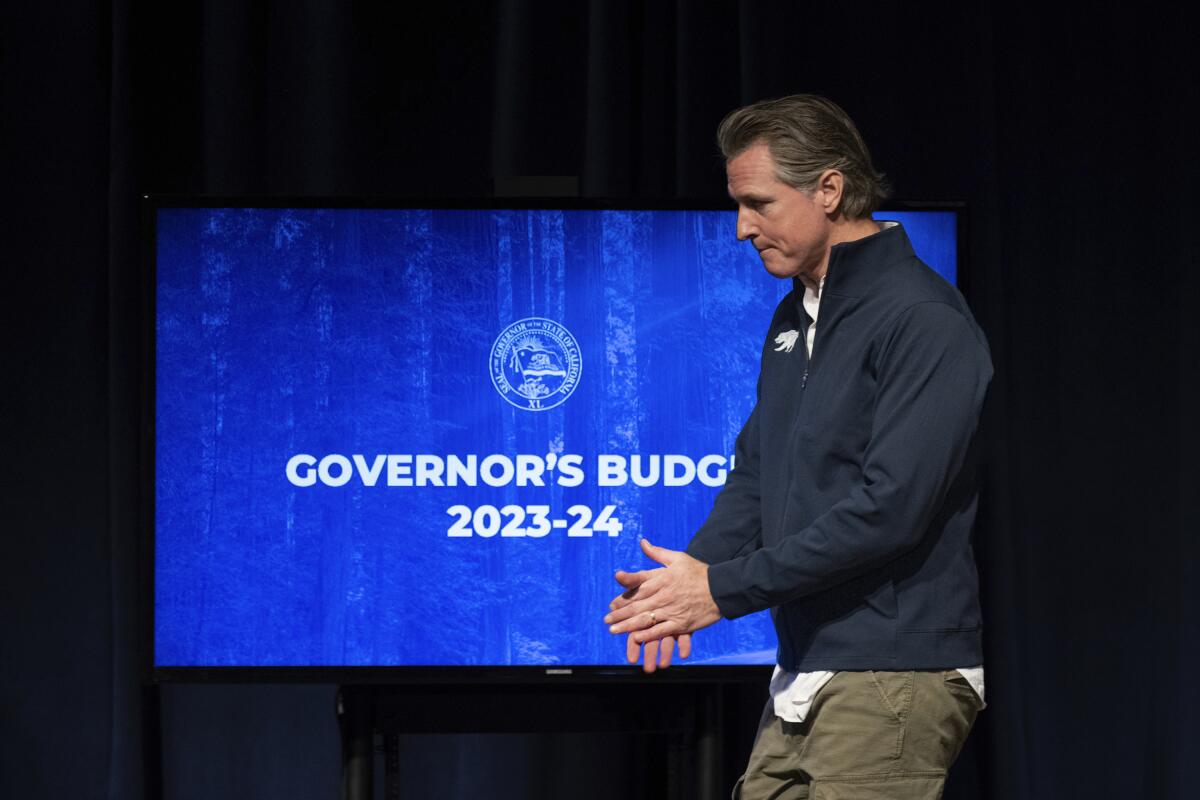California Politics: Newsom’s budget — like his jacket — preps for disaster

As California shifts from abundance to shortage, vibes were noticeably different from years past when Gov. Gavin Newsom presented his budget proposal.
- Share via
SACRAMENTO — Mea culpa: Last week I asked you to complete a survey to share your opinions about this newsletter. I’m so sorry that there was an error with the link. We’ve fixed the problem and hope you will please take a minute to complete this short survey. I really value your feedback.
Vibes were noticeably different from years past when Gov. Gavin Newsom took the stage Tuesday to present the first budget proposal of his second term. The crowd in the room was relatively small and didn’t include the cast of dignitaries that sat through his first budget presentation in 2019. He didn’t roam the stage, Ted-Talk-style, as he once did. And instead of his usual navy suit and tie, the governor was sporting a blue zip-up jacket he favors for visits to disaster zones.
Yes, Newsom was heading to the storm-ravaged coast after the budget presentation. But the choice of attire almost seemed like a metaphor for the budgetary times, as California shifts from abundance to shortage.
I’m Laurel Rosenhall, The Times’ Sacramento bureau chief, here with a few observations on the biggest stories this week in California politics:
Trimming the budget and controlling the image
After years of budgets so flush that the state sent checks home to most Californians, Newsom now must contend with a deficit. Though the projected $22.5-billion shortfall is hardly disastrous — it’s relatively modest in the scope of a roughly $300-billion budget — this budget marks the first time since taking office that Newsom has been forced to propose major reductions in his January spending plan.
The governor’s plan calls for cuts to state spending to address climate change and delaying funding for 20,000 new child-care slots, as my colleagues and I explain in this article. It also delays some other multiyear investments and shifts some expenses from the general fund to bonds to offset the shortfall. But it does not dip into the state’s rainy day fund — a sign that Newsom is worried about the possibility of a looming recession that could deepen California’s financial problems in the months and years ahead.
Schools were spared from major cuts, and Newsom included a low-cost but dramatic proposal to spend $3.5 million to stock all middle schools and high schools with naloxone, a medication used to reverse drug overdoses, amid mounting concern about children being harmed by the fentanyl and opioid crisis.
Newsom has benefited from extraordinary good luck during his first term as governor, Times columnist George Skelton writes, as the federal government showered states with cash to weather the pandemic. But now the good luck may finally be running out. The Times’ editorial board says 2023 will be the year that reality comes back to the California budget.
The low-key budget presentation came just days after Newsom staged his elaborate inauguration on the anniversary of the Jan. 6 attack on the U.S. Capitol. In an unusually personal speech, he shared anecdotes from his childhood and talked about his parents’ deaths. But he also painted a portrait of California as a progressive state determined to expand individual rights, a contrast to red-state leaders who “silence speech, fire teachers, kidnap migrants, subjugate women, attack the Special Olympics and even demonize Mickey Mouse.”
(The speech did not include the words “Ron DeSantis” but a glance at the Florida governor’s inauguration speech three days earlier sure makes it look as though they are talking to each other.)
Newsom’s inauguration was as picture perfect as a politician could hope, Times columnist Anita Chabria writes, with sunlight spilling through parted clouds and a march across a Sacramento bridge that resulted in photos reminiscent of Barack Obama’s march across the Edmund Pettus Bridge in Selma, Ala. — itself a commemoration of the civil rights march there in 1965.
But, Chabria says, the carefully choreographed event reflects Newsom’s “need to control and a focus on appearances.”
Coming up: A fight to replace Dianne Feinstein
Just ten days into 2023, the race began for California’s most consequential political contest of 2024.
On Tuesday, Democratic Rep. Katie Porter announced that she will run for the U.S. Senate seat held by America’s longest-serving woman Senator, Dianne Feinstein. On Wednesday, Democratic Rep. Barbara Lee told congressional colleagues that she also plans to run.
Feinstein is widely expected not to seek reelection next year, when she will turn 91. She told The Times last month that she will announce her intentions by the spring.
Ambitious California Democrats who crave higher office have long had their eyes on Feinstein’s seat. Retirement by the state’s senior senator, who was elected in 1992, is expected to prompt a contentious race for the coveted post. Other potential candidates include Reps. Adam B. Schiff of Burbank and Ro Khanna of Fremont, as well as Los Angeles County Supervisor Holly Mitchell and former Oakland Mayor Libby Schaaf.
“I think there will be a big battle in the primary,” former Sen. Barbara Boxer said late last year. “It’ll be fabulous.”
The truth is, the campaign to replace Feinstein has been going on in the shadows for a long time, with politicians and consultants whispering about who might run. Now, the contest has been pushed into the open, where, Times columnist Mark Z. Barabak argues, it squarely belongs.
Enjoying this newsletter? Consider subscribing to the Los Angeles Times
Your support helps us deliver the news that matters most. Become a subscriber.
What Bakersfield Republicans say about Speaker McCarthy
Kevin McCarthy’s painful quest to become House speaker that took 15 tries on live TV and a whole lot of dealmaking behind closed doors might make more sense after you read this story.
The Bakersfield Republican who found himself squeezed between the right and the ultra-right in the House faces similar dynamics at home in the Central Valley. The divides that have rankled the national GOP, humiliating McCarthy and temporarily stalling his long bid for the speaker’s gavel, are palpable in his reliably red district, which became even more conservative after new boundaries took effect last year.
Mainstream Republicans there are thrilled by McCarthy’s ascension and the spotlight it shines on the Central Valley, where conservatives have long complained about being drowned out in the halls of power by urban liberals, Times reporters Hailey Branson-Potts and Seema Mehta report. But McCarthy’s embarrassing saga was cheered on his home turf by a vocal contingent on his right, who accuse him of being a RINO — Republican in Name Only — more concerned about D.C. politics and raising money than serving the Central Valley.
Here are some takes on McCarthy’s fight for the speakership from Times opinion writers:
- Kevin McCarthy “won” the House speakership. Now the country will pay the price, writes Mark Z. Barabak
- McCarthy’s Mar-a-Lago trip was his tipping point. It showed he could be bullied into submission, writes George Skelton
- Drain the swamp? McCarthy’s House rules could weaken ethics oversight, writes The Times’ editorial board
- The fight over Kevin McCarthy becoming speaker was never about conservative ideology, writes Jonah Goldberg
Reminder: Please let us know what you think about this newsletter by completing this short survey. Your opinions are important to us.
Stay in touch
Did someone forward you this? Sign up here to get California Politics in your inbox.
Until next time, send your comments, suggestions and news tips to capolitics@latimes.com.
Sign up for Essential California
The most important California stories and recommendations in your inbox every morning.
You may occasionally receive promotional content from the Los Angeles Times.







